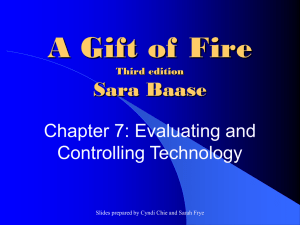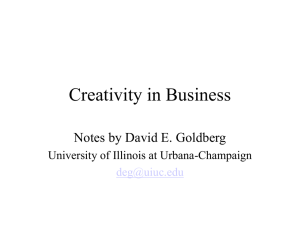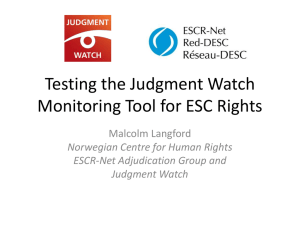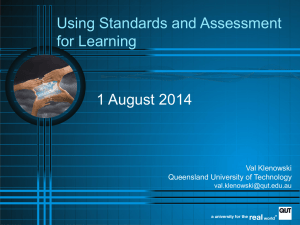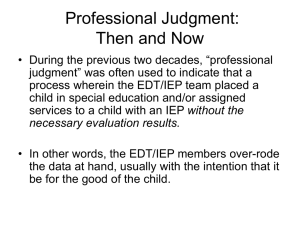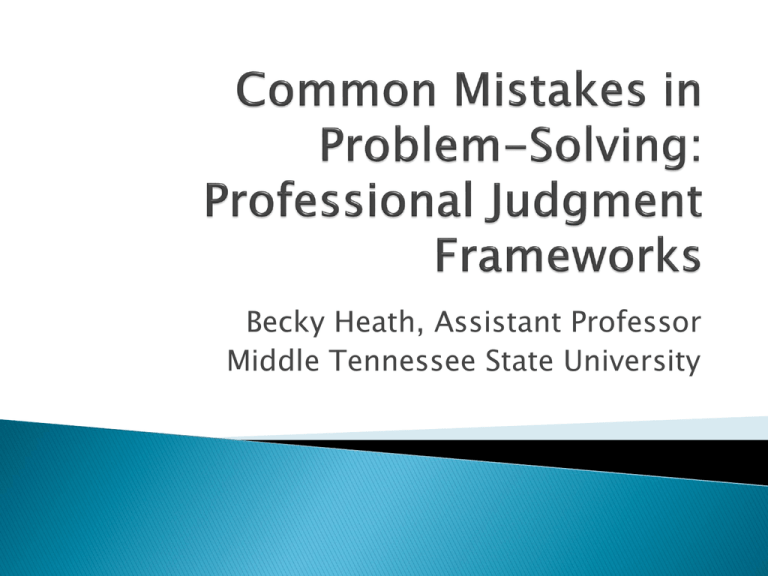
Becky Heath, Assistant Professor
Middle Tennessee State University
“Companies have substituted technology and
process for good judgment – and that
approach has failed. Hoping that better
processes and better technology will prevent
another corporate crisis is false hope.
Instead, organizational leaders must ensure
that they have the right people, in the right
places, exercising good judgment about
strategic and operational risks.”
◦ Source: Audit Director Roundtable
The increase in size, complexity and number
of activities of businesses
The increasing complexity of accounting
standards, including the expanded use of fair
value
The move toward principles-based
accounting standards
The continual monitoring of performance and
increased regulation
The decrease in the critical thinking skills of
graduates of the No Child Left Behind era
The AICPA’s website lists several
informational pieces with links:
◦ PCAOB’s “Staff Audit Practice Alert No. 10,
Maintaining and Applying Professional Skepticism in
Audits” (12/04/2012)
◦ ICAS’s A Professional Judgment Framework for
Financial Reporting Report (Aug. 2012)
◦ COSO’s Enhancing Board Oversight: Avoiding
Judgment Traps and Biases (March 2012) – based
on KPMG’s Professional Judgment Framework
◦ SEC’s “Final Report of the Advisory Committee on
Improvements to Financial Reporting to the Unites
States Securities and Exchange Commission”
(08/01/2008)
PCAOB reports both
large and smaller audit
firms exhibit
significant audit
performance
deficiencies due to a
lack of professional
skepticism.
Staff Audit Practice Alert No. 10:
Maintaining and Applying
Professional Skepticism in Audits:
"This Alert discusses factors that
impair an auditor's skepticism,
and steps that firms and auditors
can take to enhance their
application of professional
skepticism," said Martin F.
Baumann, PCAOB Chief Auditor
and Director of Professional
Standards. "PCAOB standards
require every individual auditor to
exercise professional skepticism
throughout their audits."
FOR AUDITORS
PRINCIPLE 1 - KNOWLEDGE GATHERING AND ANALYSIS
A professional auditing judgment can only be made once all relevant
information has been collected and analyzed.
PRINCIPLE 2 – ASSESSMENT OF ACCOUNTING AND AUDITING GUIDANCE:
A professional auditing judgment can only be made in the context of the
applicable accounting framework, accounting standards and other
literature where relevant, as well as the appropriate auditing standards
and guidance.
PRINCIPLE 3 - PROCESS FOR ASSESSING AND CHALLENGING THE CLIENT’S
JUDGEMENT:A professional auditing judgment can only be made after
undertaking appropriate due process to assess and challenge the client’s
judgment.
PRINCIPLE 4 – DOCUMENTATION OF JUDGMENT
A professional auditing judgment and the assessment and challenge of
the preparers’ judgment must be suitably documented.
Both frameworks consider academic research
and other studies in critical thinking and
decision-making, judgment biases and other
perspectives.
Neither framework is a mechanical or “checkthe-box” approach that eliminates discussion
and debate; rather they facilitate highquality, defensible judgments.
With respect to audits, there has been a
special focus on professional skepticism.
The professional judgment framework
Overarching considerations for
all process steps
Specific considerations
by process step
Process steps
Track, organize and evaluate considerations
For each process step, track, organize and evaluate considerations sufficient to capture relevant
information to support your judgment.
Define the
issue
Gather the
facts
Perform the
analysis
Make the
judgment
What is the
primary issue?
What is the applicable
guidance?
What information do you
need to address the issue?
Is the information you have
obtained relevant and
reliable?
How does the
applicable guidance
apply to the issue?
Have you identified and
evaluated the key
assumptions?
What are the
reasonable outcomes
and possible
alternatives?
What is your
conclusion based on
the analysis
performed?
Does your conclusion
make sense in light
of the business
purpose and
underlying
economics of the
issue?
1. Manage any personal bias and
consider the bias of others
Document
the judgment
Is the documentation
sufficient to support
your judgment?
Can another
professional
understand how you
reached your
conclusion (including
why reasonable
outcomes and
possible alternatives
identified were not
selected)?
Avoid making preliminary judgments
Consider all points of view and alternatives
Understand motivations or incentives for particular outcomes
2. Consider the risk of material misstatement
Evaluate quantitative and qualitative significance relative to the
issue and relative to the interests of stakeholders
3. Consider the involvement of others
Consider subject-matter specialists, consultation and necessary
reviews and approvals
4. Maintain professional skepticism, including fraud awareness
Maintain a questioning mindset and ask probing questions
Objectively evaluate the facts, address inconsistencies and
corroborate evidence
Assume others are neither honest nor dishonest
Be alert for indicators of possible misstatement due to error or fraud
© 2012 Ernst & Young Foundation (US). All Rights Reserved.
Academic Resource
Frames are mental structures or perspectives
that we use to determine the relevance or
importance of information.
When General Barry McCaffrey became the
nation’s “Drug Czar”, one for the first things
he did was change the metaphor or frame
that was being used by policy makers from
the “war on drugs” to “drugs are a cancer on
our nation”.
They shape our perspectives and determine
the information that we see as relevant or
irrelevant, important or unimportant.
On a financial reporting issue, alternative
frames that one might consider are the
perspective of regulators, analysts, investors,
or a hindsight perspective, such as how will
management’s judgment look if it is reported
in the press in six months?
Step 1: Defining the problem and identifying
fundamental objectives is crucial. Skipping
this step can result in time wasted solving the
wrong problem and it can severely limit the
set of alternatives available for consideration.
Step 2: It is important to consider
alternatives because our judgment can only
be as good as the best alternative considered.
Step 3 and 4: Gathering and evaluating
appropriate amounts and types of
information (Step 3) is a critical step in
coming to an informed conclusion (Step 4).
Step 5: Articulating and documenting the
rationale for the conclusion provides the
decision maker an important opportunity to
reflect on the rationale for a judgment and on
whether a sound professional judgment was
made.
“Although this 5-step process is simple and
intuitive, it is important to realize that the
judgment tendencies and shortcuts that
human beings often rely on can short-circuit
such a process, and as a result, our decisions
can be biased.”
Rush to Solve: The tendency to want to
immediately solve a problem by making a quick
judgment results in underinvestment in Steps
1and 2. Often the solution is to select the first
seemingly workable alternative.
As a result of the rush-to-solve trap,
decision makers
sometimes end up
solving the wrong
problem or they may
settle for a suboptimal
outcome.
Money ball Clip
In a group setting, this rush to solve is often
manifested as a tendency to strive toward
quick compromise and early consensus (i.e.,
groupthink).
Fostering healthy debate and avoiding early
consensus is key to avoiding unhealthy
tendencies toward suppression of view or
early, potentially premature consensus.
Decision-makers may fall into this trap
unaware and, as a result, unknowingly develop
a limited view of the problem they are
addressing, the objectives that they are trying
to achieve, and the available alternatives.
Judgment Triggers (2/6): Every judgment or
decision has an initiating force that triggers
a decision and that trigger can lead the
decision maker to skip the early steps in the
judgment process. Triggers often come in
the form of an alternative masquerading as
a problem definition, and we thus move
forward without a complete understanding
of the problem or objectives and without a
complete consideration of other
alternatives. Moneyball example…
Overconfidence (3/6): The pervasive tendency to
be overconfident can lead to suboptimal behavior
in every step of a good judgment process. Overconfidence can lead to underinvesting in defining
the problem and in identifying fundamental
objectives, the consideration of too few
alternatives, or truncating or skipping an
information search, all of which can lead to
suboptimal conclusions.
Do you think experienced professionals are more
or less inclined to fall victim to this threat?
How to mitigate the Overconfidence
Tendency:
◦ Challenge expert’s or adviser’s estimates
◦ Challenge extremely high or low estimates
◦ Challenge underlying assumptions
“The greatest obstacle to discovery
is not ignorance, it is the illusion of
knowledge.”
Daniel Boorstin (U.S. historian)
Confirmation (4/6): The confirmation tendency
and related potential judgment bias primarily
affects Steps 3 & 4. Our tendency is to seek
and overweight confirming information in the
information gathering
and evaluation steps
and to favor conclusions
that are consistent with
our initial beliefs or
preferences.
If management has taken a particular stance
in accounting for a complex transaction and
the authoritative standards are not clear on
the subject, the auditor may be likely to
seek and to place inordinate weight on
evidence that supports or “confirms”
management’s treatment of the transaction.
Mitigate the bias by being aware and seeking
and considering disconfirming or conflicting
information.
Anchoring (5/6): This tendency primarily
affects the gathering and evaluating of
information. It is human nature to anchor
on an initial value and adjust insufficiently
away from that value in making our final
assessments.
Potential anchors are abundant in business
settings: management estimates, historical
data, industry data, past experience…
Availability (6/6): This is the tendency for
decision makers to consider information that is
easily retrievable from memory as being more
likely, more relevant, and more important for a
judgment. The availability tendency can have
particular influence when considering alternatives
and evaluating evidence.
Example: An auditor who identified a
significant amount of unrecorded liabilities
on a prior audit is likely to overestimate the
likelihood of the presence of unrecorded
liabilities on a subsequent audit.
Step 1: Clarify Issues & Objectives
http://www.youtube.com/watch?v=4oS0YzHBAGQ&fea
ture-youtu.be
Step 2: Consider Alternatives
http://www.youtube.com/watch?v=ck6tURJ71w&feature-youtu.be
Step 3 : Gather & Evaluate Information
http://www.youtube.com/watch?v=qTjREYcGzyo&featu
re-youtu.be
1.
2.
3.
Increased projected margins by ____%
Client suggests it will be able to fully realize
NOL
Factors client used to justify increase in
margins: lease dayrate; operator
percentage, rig ________, _____ operating,
and projected margins
1. (lease dayrate and operator % are known factors
(contracts; advance pricing agreement); others are
estimates
4.
Client using ____ years of projected profits
_________
Alternatives
________________ Alternatives
________________ Alternatives
________________ Alternatives
http://www.youtube.com/watch?v=DztX64AuQM&feature-youtu.be
Would additional work be required?
What kind?
◦ Test to ensure that all elements of the workpaper
are consistent with prior tested assumptions and
/or projections
◦ We might question management’s ability to
reasonably estimate other items in the calculation
and if they can project 9 years into the future.
www.KPMGUniversityConnection.com
Rigorous or Not?
Suggested Solutions
Projected
Margins
Gross NOL
BOY
Current Year
NOL
Generated /
Applied
Gross NOL
EOY
Projected
NOL
Application
Valuation
Allowance (if
< 0, none
recognized)
10%
2012
DTA
11%
2012
DTA
12%
2012
DTA
13%
2012
DTA
11,072,746
11,072,746
11,072,746
11,072,746
9,021,088
9,021,088
9,021,088
9,021,088
14%
2012
DTA
14.5%
2012
DTA
15.0%
2012
DTA
11,072,746
11,072,746
Valuation11,072,746
Allowance
NOT needed at 15%
projected
margin9,021,088
9,021,088
9,021,088
20,093,833
Valuation Allowance
20,093,833 needed
20,093,833at 14.5%
20,093,833
projected margin
20,093,833
20,093,833
20,093,833
13,403,340
14,743,674
16,084,008
17,424,342
18,764,677
19,434,844
20,105,011
6,690,493
5,350,159
4,009,825
2,669,491
1,329,157
658,990
(11,177)
© 2013 KPMG LLP, a Delaware limited liability partnership and the U.S. member firm of the KPMG network of independent member firms affiliated with
KPMG International Cooperative (“KPMG International”), a Swiss entity. All rights reserved. © 2013 Jan Taylor Morris
27
www.KPMGUniversityConnection.com
Rigorous or Not?
A Case for Auditor Judgment for Deferred Tax Issues
Video Section 5
© 2013 KPMG LLP, a Delaware limited liability partnership and the U.S. member firm of the KPMG network of independent member firms affiliated with
KPMG International Cooperative (“KPMG International”), a Swiss entity. All rights reserved. © 2013 Jan Taylor Morris
28
The auditor, Stone, is proposing an adjustment
to the client’s Valuation Allowance account. She
notes that the workpapers will be documented to
fully reflect both the auditor’s and client’s
positions and that the remaining documentation
will be dependent upon the client’s decision to
revise the estimate to the more supportable 10%
projected margin or not.
Do you think the auditor should question
management’s estimates in other areas, such as
the Allowance for Uncollectible Receivables?
The Tax Director mentioned that the
Company uses “a conservative approach”
in determining the profit margin for
forecasting future taxable income and
corresponding NOL utilization.
According to professional accounting
and auditing standards and using
professional judgment, do you agree
with the client’s approach?
DUH?!?
Awareness of the common threats to good
judgment is the key initial step in improving
judgment.
In addition to the five framework steps, consider
the following overarching considerations
throughout the process of making a judgment:
◦ Consider materiality (i.e., the quantitative and qualitative
significance of the issue)
◦ Involve others with subject matter expertise or more
experience
◦ Manage any personal bias or bias of others
◦ Maintain professional skepticism, including fraud
awareness
http://www.kpmguniversityconnection.com/P
rofessionalJudgment/CurriculumSupport/



